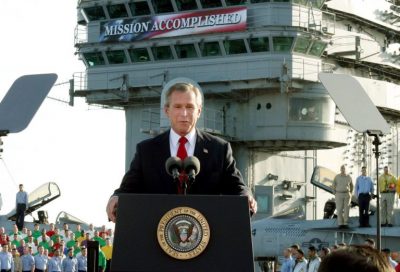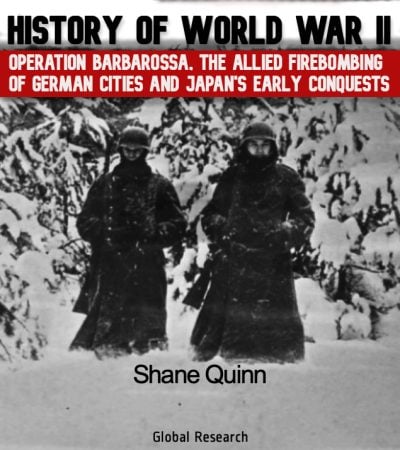Historical analysis: The Patriot Act, The National Security Strategy (NSS), the “War on Terrorism”

All Global Research articles can be read in 51 languages by activating the Translate Website button below the author’s name.
To receive Global Research’s Daily Newsletter (selected articles), click here.
Follow us on Instagram and Twitter and subscribe to our Telegram Channel. Feel free to repost and share widely Global Research articles.
***
On 25 October 2001, less than 3 weeks after the United States launched an attack on Afghanistan, a very large majority in the US Congress passed the Patriot Act, which was promptly signed into law by president George W. Bush. This inflicted a blow upon America’s domestic legal structure by violating the US Constitution.
The Patriot Act enlarged the powers of the state for increased surveillance of its own citizens, to be conducted through the National Security Agency (NSA), an intelligence apparatus of the US Department of Defense. The Patriot Act formulated the new crime in America of “domestic terrorism”, and in such an expansive fashion that it could be used against any perceived civil misdemeanour.
The Patriot Act laid the groundwork for the de facto creation of a police state. The Pentagon, whose base of operations had centred on the military, was now focusing somewhat on internal issues in the American political system which was an infringement of US law, violating the 1878 Posse Comitatus Act. This legislation forbids the US Armed Forces from interfering within domestic political activities, unless the military has authorisation from the US Congress.
On 17 September 2002, president Bush announced the National Security Strategy of the United States. He declared that the “war on terror” could not be won by defensive methods, and that the US reserved the right to wage pre-emptive or preventive wars unilaterally, even if such actions were unprovoked and located on the other side of the world (Afghanistan, Iraq), including the right to use nuclear weapons against non-nuclear states.
This year Western media and politicians have repeatedly accused Russia of launching an “unprovoked invasion” of its Ukrainian neighbour, a region that for centuries had been part of Russia, an historical fact which is persistently overlooked in the West. Neither do they mention the roots of the Ukraine crisis: NATO’s continual expansion from the 1990s to rest upon the frontiers of Russia itself. The philosopher and analyst Alexander Dugin highlighted,
“From where the land leaves, the sea comes there. This is the law. Three Baltic territories were immediately included in NATO. The rest got in line”.
It was openly planned at NATO conferences to incorporate the former Soviet republics, the Ukraine and Georgia, into the military organisation. The NATO-armed and supported AFU have regularly bombarded areas like the Donbass, which has been under threat of a large-scale AFU ground assault. Over a number of years this has represented a severe provocation of Russia, discrediting Western allegations that the Russians launched an unprovoked military intervention.
It seems clear that Kiev and its NATO sponsors cannot be victorious in the conflict versus Russia, without access to the critically important areas that the AFU have retreated from. Michel Chossudovsky, a geostrategist and economist, wrote convincingly,
“In regards to the Ukraine War, Russia’s control of the Kerch Strait plays a key role. In recent developments (June 2022), Russia now controls the entire basin of the Sea of Azov. Ukraine has no maritime access to the Sea of Azov and Eastern Ukraine, nor does it have naval power in the Black Sea. Without a navy (and without an Air Force which was destroyed at the outset in late February), Ukraine is not in a position to win this war”.
Meanwhile, president Bush’s support of waging preventive wars had not been a recent phenomenon. It instead constitutes a traditional hallmark of imperial powers. Field Marshal Wilhelm Keitel, a prominent World War II German commander, wrote in his memoirs in 1946 that against the USSR the Wehrmacht from 1941 had launched “the preventive war which alone would suffice to halt the Bolshevik steamroller in its tracks, before Europe had succumbed to it”. Keitel maintained further that the USSR had made “preparations to attack us”.
Keitel’s claims are not true. Soviet Russia was not planning an offensive against Nazi Germany. The Soviet leader Joseph Stalin hoped, in reality, to delay war with the Third Reich for as long as necessary. Vyacheslav Molotov, the Soviet Foreign Minister, recalled how Stalin had strongly hinted, shortly after the Fall of France, that he wanted to put off war with the Germans until 1943 if possible, in order to give the Soviets more breathing space. Stalin was aware that a conflict with Nazi Germany was inevitable and entailed much risk. The Soviet Union and the Third Reich were the two strongest military powers in the world.
As Keitel indirectly referred to, the Soviet Army was lavishly equipped with weaponry in 1941, a rearmament policy which Moscow had correctly pursued because of the fear of war being unleashed on Soviet Russia, not only by the Germans; the Russians suspected too, with good reason, that the Western states would support a Nazi invasion of Russia, or participate in it alongside Germany. European nations like Spain, Italy, Romania and Croatia each sent forces to fight with the Nazis against Russia.
Very little American Lend-Lease aid was shipped to Russia in 1941, as the Red Army that year prevented the Germans from capturing Moscow and Leningrad, and in doing so turned the war around in Russia’s favour. US military hardware started to appear in modest amounts in Russia during 1942, only after the Red Army had overcome the worst of the Nazi onslaught.
There were crucial gaps in 1942, primarily during the autumn and early winter periods, when the US military assistance to Russia was significantly reduced, which prompted renewed suspicions in Moscow. During a 3 and a half month period in 1942, when the fighting was raging in the Caucasus and Stalingrad, less than 40 ships carrying Lend-Lease cargo entered the Russian ports of Murmansk and Arkhangelsk. This suggests the Americans had very mixed feelings about an alliance with Russia. Moreover, considerable amounts of US military equipment sent to Russia was of poor quality, like the P-40 fighter aircraft.
President Bush claimed in September 2002 that his administration was intent on “fighting terrorists and tyrants” wherever needed, actions which could only be achieved through military force. On 19 March 2003 the Bush White House, with the firm backing of the Tony Blair regime in London, sent the US Air Force to bomb the Iraqi capital Baghdad, and the following day a huge ground assault on Iraq began. Washington demanded that Saddam Hussein and his sons, Uday and Qusay, surrender and leave Iraq within 2 days. The Anglo-American invasion was initiated without the support of their key NATO allies, France and Germany, or the UN Security Council.
On 29 September 2006, following approval by the House of Representatives, the US Senate ratified the Military Commissions Act (MCA) by 65 votes against 35 as part of the “war on terror”; and president Bush then signed the MCA on 17 October 2006. It granted him with unprecedented powers in the history of the US. Washington could deny the right to habeas corpus for US citizens detained as “unlawful enemy combatants”, and not merely for those partaking in combat but also for people who “purposefully and materially supported hostilities against the United States”.
With the passing of the Military Commissions Act, those imprisoned in Afghanistan and sent to the Guantanamo Bay military prison could not appeal to the courts of justice in America. US Secretary of Defense Donald Rumsfeld said before that “technically unlawful combatants do not have any rights under the Geneva Convention”.
The White House was bestowed with the power to detain indefinitely any American or foreign national, in the US and overseas, who was discovered in possession of material supporting activities against America; and the act sanctioned the use in prisons of torture (“enhanced interrogation techniques” [ETI]) relating to sleep and sensory deprivation, solitary confinement, waterboarding and forced medication.
US military personnel and CIA operatives were allowed to commit “enhanced interrogation techniques”, and the testimonies extracted under such circumstances were used in trials by military commissions. The Center for Constitutional Rights, headquartered in New York, felt the Military Commissions Act to be “a massive legislative assault on fundamental rights, including the right to habeas corpus – the right to challenge one’s detention in a court of law”.
Guantanamo received dozens of prisoners under the age of 18. For example sent to Guantanamo early in 2003 was Mohamed Jawad from Pakistan, who the Americans purported had thrown an explosive device at a US-owned military vehicle in Kabul, Afghanistan, which wounded 2 American soldiers and their interpreter. Jawad’s family insisted he was 12-years-old when arrested, while the Pentagon stated that Jawad’s age was about 17 according to a bone scan.
Jawad was not released from Guantanamo until nearly 7 years later in 2009. Erik R. Saar, a US Army sergeant based at Guantanamo, wrote that he “had to wonder about the wisdom of keeping kids so young in a place like Gitmo [Guantanamo]”. In 2008 there were 21 prisoners at Guantanamo below the age of 18.
The White House’s excuse when criticised for severe breaches of human rights in places like Guantanamo, located on the shores of south-eastern Cuba, is that since it is not officially part of the US, the area does not fall under the jurisdiction of America’s courts of justice or international law. The establishment of US control over Guantanamo, which is a major Cuban port, has allowed Washington to evade US law and the Geneva Convention.
The CIA established other secret prisons in NATO states such as Poland, Romania and Lithuania, and in the Middle East and Asia. Agents from the CIA and FBI along with other government officials could interrogate prisoners as they saw fit.
The Bush administration was advancing its military and political ambitions in the highly-prized Caucasus region. This led inevitably to rising tensions between Washington and Moscow. The US failed to respect the Kremlin’s legitimate concerns regarding a region that is on Russia’s doorstep, and which president Vladimir Putin believes to be within his country’s sphere of interest, as the Caucasus has been historically.
President Bush sent 200 military advisers to Georgia, and Russian officials, aware of the encroachment, complained to Washington about the presence of US troops on Georgian soil. The US established NATO’s Partnership for Peace Program (NATO-PfP) pertaining to the ex-Soviet republics, and the US military had been conducting exercises in the former territories of the Soviet Union since 1997.
Yet Bush’s government was aware that other means were needed to reach their goals, rather than solely armed persuasion. Interfering once more on the international scene was the liberal billionaire George Soros and his Open Society Institute, renamed Open Society Foundations in 2011. The policies of Soros and his Open Society groups are usually compatible with Washington, nor do they feel the need to always go about their business diplomatically, something which USAID at least keeps up the pretence of doing.
Soros’ Open Society groups have funnelled tens of millions of dollars into the former Soviet republics. In the autumn of 2003 alone, Soros poured $42 million into assisting the so-called Rose revolution in Georgia, which helped the US-friendly Mikheil Saakashvili to come to power in January 2004. Soros was involved too in the Ukrainian “Orange revolution”, that enabled the pro-Western Viktor Yushchenko to become president in Kiev in January 2005. The next month Yushchenko spoke of his desire to seek Ukrainian accession to NATO.
Also setting in motion the above color revolutions were American and European organisations like USAID, the Poland-America-Ukraine Cooperation Initiative, Freedom House, and the National Endowment for Democracy (NED). These groups managed to sustain the electoral campaign of Yushchenko, which otherwise would probably have failed.
The color revolutions actually resembled something like coups d’etat, and drew similarities with the Anglo-American-led 1953 putsch in Iran. Here, the British MI6 and CIA had funded demonstrations and other unrest in the capital Tehran, in order to topple the Iranian prime minister Mohammad Mosaddegh and replace him with someone more obedient, the Shah as it turned out. Mosaddegh had put Iran’s precious oil reserves under state control.
*
Note to readers: Please click the share buttons above or below. Follow us on Instagram and Twitter and subscribe to our Telegram Channel. Feel free to repost and share widely Global Research articles.
Shane Quinn obtained an honors journalism degree and he writes primarily on foreign affairs and historical subjects. He is a Research Associate of the Centre for Research on Globalization (CRG).
Sources
Wilhelm Keitel, The Memoirs of Field Marshal Keitel (William Kimber and Co. Limited; 1st edition, 1965)
Michel Chossudovsky, “The Kerch Strait and the Sea of Azov: Black Sea Geopolitics and Russia’s Control of Strategic Waterways”, Global Research, 12 October 2022
Robert Service, Stalin: A Biography (Pan; Reprints edition, 16 April 2010)
Alexander Dugin, “NWO And The Change Of The World Order”, Geopolitica, 10 October 2022
Chris Bellamy, Absolute War: Soviet Russia in the Second World War (Pan; Main Market edition, 21 Aug. 2009)
Guardian, “One of Guantanamo’s youngest inmates to sue US over seven lost years”, 28 August 2009
Washington Post, “The Prisoner Question”, 3 February 2002
Luiz Alberto Moniz Bandeira, The World Disorder: US Hegemony, Proxy Wars, Terrorism and Humanitarian Catastrophes (Springer; 1st ed., 4 Feb. 2019)
Guardian, “Ukraine seeks NATO relationship”, 22 February 2005
Luiz Alberto Moniz Bandeira, The Second Cold War: Geopolitics and the Strategic Dimensions of the USA (Springer; 1st ed., 23 June 2017)
Featured image: George W. Bush declares victory in Iraq War, USS Abraham Lincoln, San Diego, May 1, 2003

History of the World War II
Operation Barbarossa, the Allied Firebombing of German Cities and Japan’s Early Conquests
By Shane Quinn
The first two chapters focus on German preparations as they geared up to launch their 1941 invasion of the Soviet Union, called Operation Barbarossa, which began eight decades ago. It was named after King Frederick Barbarossa, a Prussian emperor who in the 12th century had waged war against the Slavic peoples. Analysed also in the opening two chapters are the Soviet Union’s preparations for a conflict with Nazi Germany.
The remaining chapters focus for the large part on the fighting itself, as the Nazis and their Axis allies, the Romanians and Finns at first, swarmed across Soviet frontiers in the early hours of 22 June 1941. The German-led invasion of the USSR was the largest military offensive in history, consisting of almost four million invading troops. Its outcome would decide whether the post-World War II landscape comprised of an American-German dominated globe, or an American-Soviet dominated globe. The Nazi-Soviet war was, as a consequence, a crucial event in modern history and its result was felt for decades afterward and, indeed, to the present day.


